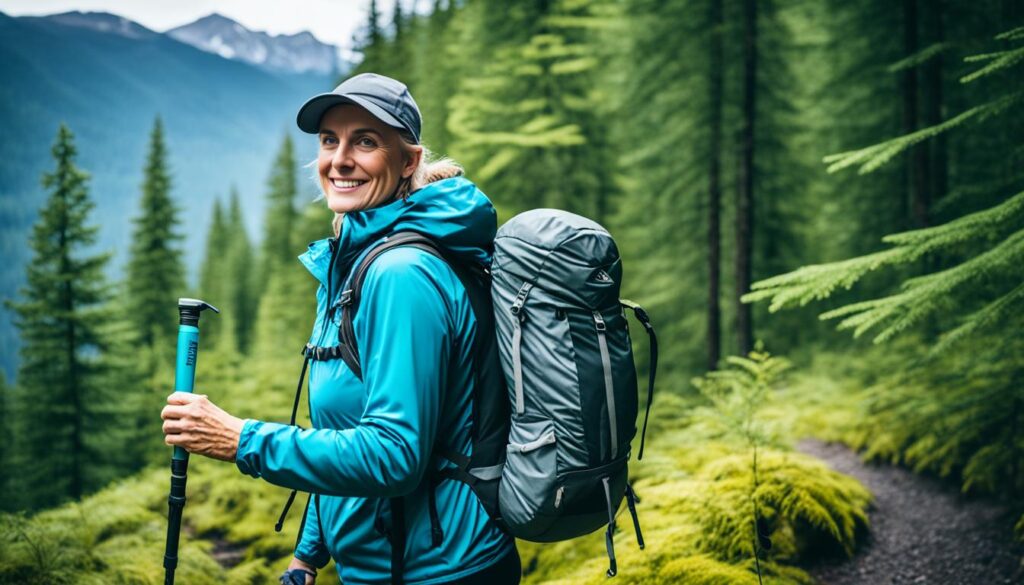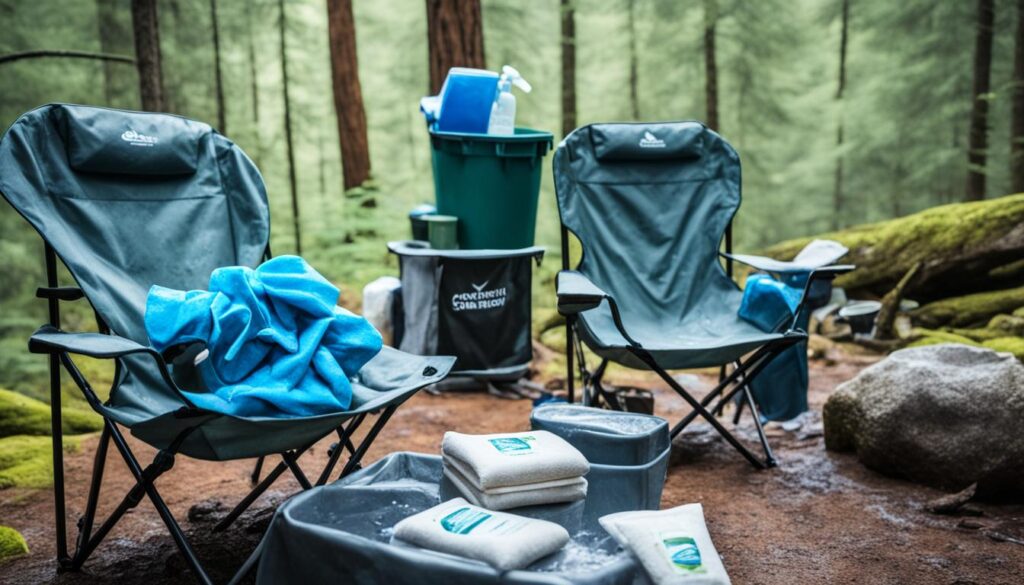When it comes to dressing for a camping trip, it’s important to prioritize functionality and practicality. The right clothing can protect you from the elements, keep you comfortable, and enhance your overall camping experience. Whether you’re camping in the spring, summer, fall, or winter, there are certain clothing items that are essential for all seasons. By carefully selecting your camping outfits, you can ensure that you’re prepared for the weather, activities, and potential challenges of the outdoors.
Key Takeaways:
- Consider the functionality and practicality of your camping outfits.
- Pack clothing items that are appropriate for the weather and activities.
- Select moisture-wicking and quick-drying materials for comfort.
- Layer your clothing to adapt to changing temperatures.
- Choose functional and durable clothing that can withstand outdoor activities.
When packing clothes for camping, it’s important to consider the weather forecast, the length of your trip, and the specific activities you plan to engage in. Start by checking the weather for your destination and pack clothes appropriate for the expected climate. Consider the duration of your camping trip and pack enough clothes to last the entire duration. Choose versatile pieces that can be layered or mixed and matched for different activities. Focus on packing functional and durable clothing items that can withstand outdoor activities and potential messes. Don’t forget to pack extra socks and underwear, as these items tend to get dirty quickly.
Key Takeaways:
- Pack clothes appropriate for the weather and climate of your destination.
- Pack enough clothes to last the entire duration of your camping trip.
- Choose versatile pieces that can be layered or mixed and matched.
- Focus on functional and durable clothing that can withstand outdoor activities.
- Don’t forget to pack extra socks and underwear.
Contents
- 1 Why Is It Important to Pack Carefully for Camping?
- 2 Camping Outfit Ideas for Every Season
- 3 Strategies for Packing the Right Clothes for Camping
- 4 Tips for Dressing Comfortably and Practically While Camping
- 5 How to Protect Yourself and Your Clothes While Camping
- 6 Essential Camping Clothing Checklist
- 7 FAQ
- 8 Source Links
Why Is It Important to Pack Carefully for Camping?
When preparing for a camping trip, packing the right clothing is essential for a successful outdoor experience. By carefully selecting your camping wardrobe essentials and following these camping fashion tips, you can ensure comfort, protection, and enjoyment throughout your adventure.
Comfortable Camping Clothes
Comfort should be a top priority when choosing camping attire. Opt for loose-fitting and breathable clothing made from comfortable materials such as cotton or moisture-wicking fabrics. This will help keep you cool and dry during your outdoor activities.
Camping gear for clothing can also enhance your comfort. Invest in quick-drying socks and pants, which provide moisture control and prevent chafing. Additionally, consider wearing layers to adapt to changing temperatures. This allows you to easily add or remove clothing as needed.
Protection from the Elements
Packing appropriate clothing is vital for protecting yourself from the elements. For sun protection, wear a wide-brimmed hat and pack lightweight, quick-drying clothing with UPF (Ultraviolet Protection Factor) for added sun protection.
When camping in bug-prone areas, choose clothing that covers your skin to avoid insect bites. Long-sleeved shirts, pants, and socks, along with bug repellent, can help ward off mosquitoes and other bugs.
Clothing Durability
While camping, your clothes may encounter dirt, mud, and outdoor activities that can potentially ruin them. Selecting durable clothing that can withstand the rigors of camping is crucial. Look for reinforced stitching, high-quality fabrics, and stain-resistant materials to ensure your clothes last throughout your trip.
Activity-Specific Clothing
Consider the specific activities you plan to engage in during your camping trip. If you’re planning on hiking or rock climbing, pack rugged and flexible clothing that allows for ease of movement. If you’re camping near a lake or river, include swimwear for a refreshing dip.
Having the best clothes for camping can enhance your overall experience and allow you to fully immerse yourself in nature. Pack clothes that make you feel comfortable, protected, and ready for any outdoor adventure.
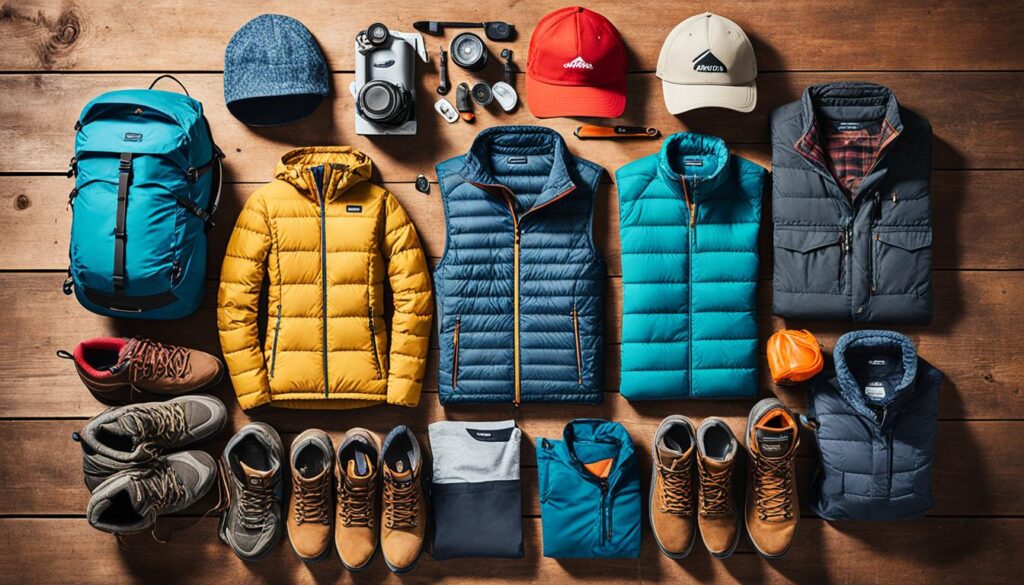
| Camping Wardrobe Essentials | Camping Fashion Tips |
|---|---|
| Comfortable clothing made of breathable materials | Invest in camping gear for clothing |
| Protective clothing for sun and bug protection | Choose clothing that can withstand outdoor activities |
| Layered clothing for temperature adaptability | Consider activity-specific clothing |
Camping Outfit Ideas for Every Season
When it comes to camping, dressing appropriately for the season is key to ensure comfort and enjoyment during your outdoor adventures. From spring to winter, each season brings different weather conditions and challenges that call for specific clothing choices. Here are some camping outfit ideas for every season:
Spring
For spring camping trips, it’s important to pack clothing that can handle fluctuating temperatures and potential rain showers. Opt for moisture-wicking shirts or tank tops made of high-tech polyester fabric to keep you cool and dry. Layer up with sweatshirts or long-sleeve shirts for cooler evenings. Don’t forget to bring a rain jacket in case of unexpected showers. And if there’s a chance to swim, pack a swimsuit to take a refreshing dip in nearby lakes or rivers.
Summer
Summer camping calls for lightweight and breathable clothing. Choose loose-fitting shirts and shorts made of moisture-wicking materials to stay cool and comfortable in the heat. Don’t forget to pack a sun hat to protect yourself from the sun’s rays. Quick-drying shorts or pants are ideal for outdoor activities and can easily transition from hiking to swimming. And as always, bring a rain jacket for any unexpected summer storms.
Fall
In the fall, temperatures can vary greatly during the day and night, so layering is key. Start with a moisture-wicking base layer, such as a long-sleeve shirt, and add a fleece or sweatshirt for extra warmth. Opt for quick-drying pants or leggings and bring a hat and gloves for chilly mornings and evenings. A lightweight and packable down jacket is perfect for colder fall adventures.
Winter
Winter camping requires warm and insulating clothing to combat the cold temperatures. Layering becomes even more important during this season. Start with a moisture-wicking base layer, followed by a fleece or wool sweater to provide insulation. Thick, waterproof pants and a warm winter coat are essential. Don’t forget to pack a hat, gloves, and thermal socks to protect your extremities from the cold.
Remember to always check the weather forecast before packing for your camping trip and adjust your clothing choices accordingly. By packing the right clothing for each season, you’ll stay comfortable and prepared for whatever the great outdoors throws at you.
Strategies for Packing the Right Clothes for Camping
When preparing for a camping trip, packing the right clothes is essential to ensure comfort, protection, and mobility in the great outdoors. To make sure you’re well-prepared, follow these strategies:
- Check the weather forecast: Before packing, take a look at the weather forecast for your camping destination. This will help you determine the appropriate clothing for the expected climate. Pack accordingly, whether it’s sunny and warm or rainy and chilly.
- Consider the length of your trip: Take into account the duration of your camping trip when packing clothes. Make sure to pack enough clothes to last the entire duration, including extra socks and underwear, as these tend to get dirty quickly.
- Choose versatile pieces: Opt for clothing items that can be layered or mixed and matched for different activities. This way, you can adapt your outfit to changing temperatures throughout the day and be prepared for various outdoor adventures.
- Focus on functionality and durability: Select clothing items that are functional and durable, able to withstand outdoor activities and potential messes. Look for materials that are moisture-wicking, quick-drying, and resistant to tears and abrasions.
- Don’t forget the essentials: In addition to clothing, ensure you pack other camping wardrobe essentials such as a hat, sunglasses, sturdy footwear, and a rain jacket. These items will provide further protection from the elements and enhance your overall camping experience.
By following these strategies, you’ll be well-equipped with the right clothes for your camping trip, allowing you to fully enjoy the wonders of the great outdoors.
Gear up with the essentials - A Packing Checklist for Camping Clothes:
| Item | Quantity |
|---|---|
| Moisture-wicking shirts | 3-4 |
| Quick-drying shorts/pants | 2-3 |
| Underwear | 3-4 pairs |
| Socks | 3-4 pairs |
| Sweatshirt or long-sleeve shirt (for cooler evenings) | 1-2 |
| Rain jacket | 1 |
| Hat | 1 |
| Sunglasses | 1 |
| Sturdy footwear (hiking boots, sandals, etc.) | 1 pair |
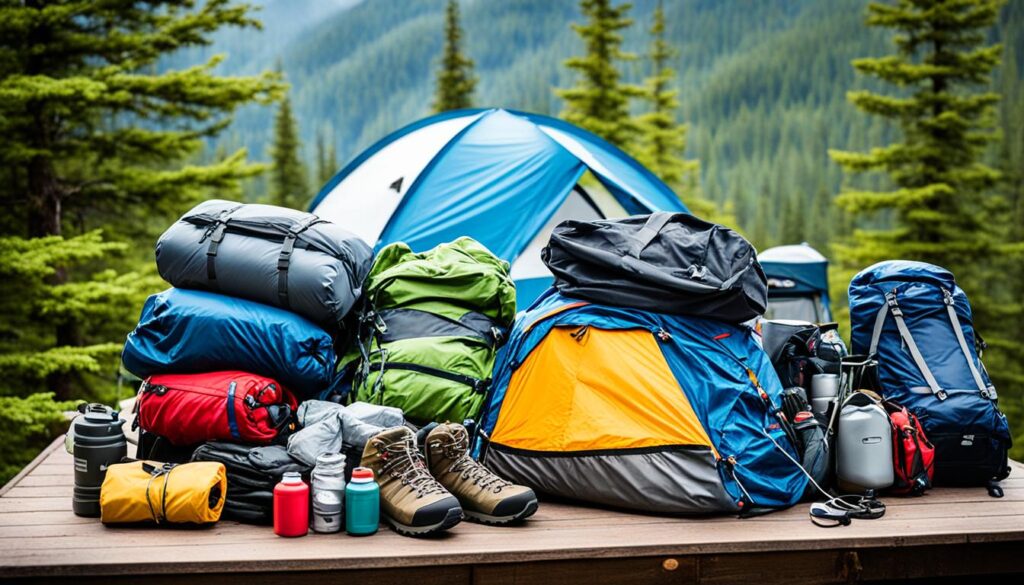
Keep in mind that this is just a general guideline and you may need to adjust it based on your personal preferences, specific activities planned, and the duration of your camping trip. Stay prepared, pack smart, and make the most of your camping adventures!
Tips for Dressing Comfortably and Practically While Camping
Dressing comfortably and practically while camping is essential to fully enjoy your outdoor experience. When it comes to choosing the right camping clothes, there are a few key factors to consider: comfort, functionality, and durability. Opt for loose-fitting and breathable clothing made of moisture-wicking materials to keep you cool and dry during your camping adventures. Avoid tight or restrictive clothing that may limit your mobility and cause discomfort.
Layering is important when camping, as the temperature can fluctuate throughout the day and night. Pack items that can easily be added or removed as needed, such as lightweight jackets, long-sleeve shirts, and versatile pants. This allows you to adapt to changing weather conditions and stay comfortable throughout your camping trip.
Investing in camping gear designed for clothing can greatly enhance your comfort and performance in the outdoors. Quick-drying socks and pants are great examples of such gear, as they help to keep you dry and prevent chafing during physical activities. Additionally, consider wearing sun-protective clothing and accessories, such as wide-brimmed hats and UV-protective shirts or pants, to shield yourself from harmful rays.
Comfortable footwear is also a must-have for camping. Choose shoes or hiking boots that provide ample support, cushioning, and protection for your feet. Look for features like arch support, sturdy soles, and waterproof materials to ensure that your feet stay comfortable and dry, even during long hikes or wet conditions.
Remember, camping is all about enjoying nature while staying comfortable and safe. By selecting the right camping clothes and gear, you can have a fantastic outdoor experience, whether you’re hiking, fishing, or simply relaxing by the campfire. So, pack your comfortable camping clothes, follow these practical fashion tips, and get ready for a memorable camping adventure.
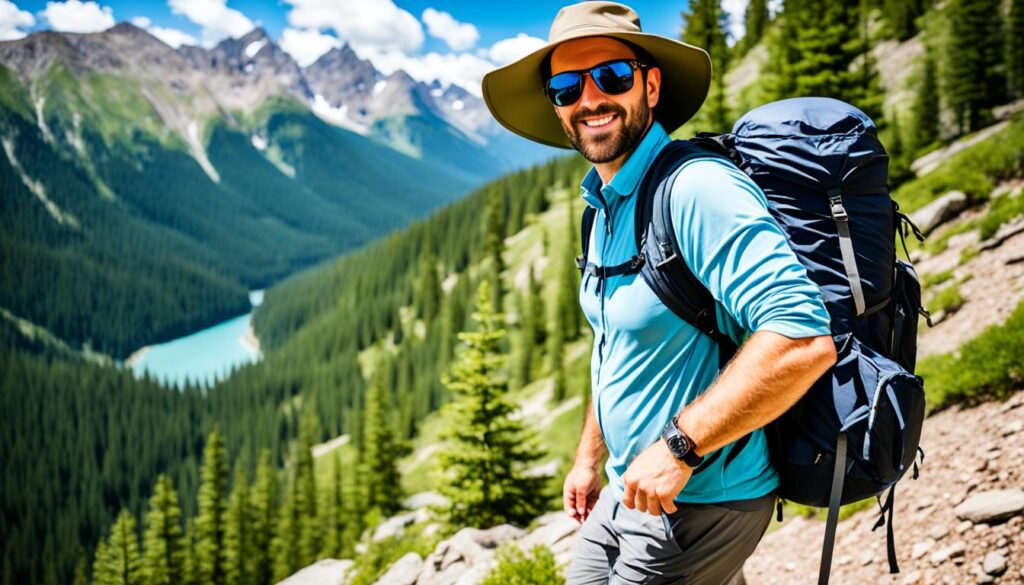
| Clothing Item | Description |
|---|---|
| Moisture-wicking shirts | These shirts are made of breathable fabrics that wick away sweat, keeping you cool and dry. |
| Quick-drying pants | These pants are designed to dry quickly, making them ideal for water activities or unexpected rain showers. |
| Lightweight jackets | A lightweight jacket provides an extra layer of warmth for cool evenings or chilly mornings. |
| Sun-protective clothing | These clothing pieces have UPF (ultraviolet protection factor) to shield your skin from the sun’s harmful rays. |
| Wide-brimmed hats | Protect your face and neck from the sun by wearing a wide-brimmed hat. |
| Comfortable footwear | Choose shoes or boots that provide support, cushioning, and protection for your feet during outdoor activities. |
How to Protect Yourself and Your Clothes While Camping
While camping, it is important to take steps to protect yourself and your clothes from various outdoor elements. Here are some essential tips to help you stay prepared:
1. Use Bug Spray and Wear Protective Clothing
Protect yourself from bugs and sunburn by using bug spray and wearing clothing that covers your skin. Opt for lightweight, long-sleeve shirts and pants made of breathable materials to keep insects at bay while staying comfortable.
2. Avoid Bright Colors and Scented Products
When camping, it’s best to avoid wearing bright colors and using scented lotions or perfumes. These can attract insects and potentially disrupt your outdoor experience. Stick to neutral-colored clothing and fragrance-free products to minimize attracting unwanted attention from bugs.
3. Pack Separate Sleeping Clothes
To keep your sleeping environment clean and dry, pack a separate set of clothes for sleeping. These clothes should be comfortable and lightweight, allowing you to get a good night’s sleep without worrying about getting your daytime clothes dirty or wet.
4. Utilize Waterproof Bags or Plastic Bags
Invest in waterproof bags or use plastic bags to separate your dirty clothes from clean ones. This ensures that any dirt or moisture from your outdoor activities doesn’t affect your fresh outfits. Additionally, it helps you stay organized and makes it easier to find what you need during your camping trip.
5. Clean and Store Your Camping Clothes Properly
After each camping trip, take the time to properly clean and store your camping clothes. This will help extend their lifespan and prevent any odors or mildew from developing. Follow the care instructions provided by the clothing manufacturer and use appropriate detergents to maintain the quality of your camping attire.
| Protective Measures | Description |
|---|---|
| Bug Spray and Protective Clothing | Use bug spray and wear clothing that covers your skin to protect yourself from bugs and sunburn. |
| Avoid Bright Colors and Scented Products | Avoid wearing bright colors and using scented products to minimize attracting insects. |
| Separate Sleeping Clothes | Pack separate clothes for sleeping to keep them clean and dry. |
| Waterproof Bags or Plastic Bags | Use waterproof bags or plastic bags to separate dirty clothes from clean ones. |
| Clean and Store Properly | Properly clean and store your camping clothes after each trip to prevent odors and maintain their quality. |
Essential Camping Clothing Checklist
When preparing for a camping trip, having the right clothing is key to staying comfortable and protected in the great outdoors. Here are some essential camping wardrobe essentials that should be on your packing checklist:
1. Layering pieces: Pack lightweight, moisture-wicking shirts and pants that can be layered for varying temperatures. Opt for materials like polyester and merino wool, which are breathable and quick-drying.
2. Outerwear: Be prepared for changing weather conditions by packing a waterproof and windproof jacket. A good pair of hiking boots or sturdy walking shoes is also essential for outdoor adventures.
3. Sun protection: Don’t forget to bring a wide-brimmed hat, sunglasses, and sunscreen to shield yourself from the sun’s harmful rays. Consider packing lightweight long-sleeve shirts and pants for added protection.
4. Comfortable sleepwear: Pack cozy sleepwear, such as moisture-wicking pajamas or thermal layers, for a good night’s sleep in the tent.
5. Accessories: Remember to pack essentials like socks, underwear, and a swimsuit for any water activities. You may also want to bring a lightweight scarf, gloves, and a beanie for cooler evenings.
By including these camping clothing essentials in your packing list, you’ll be well-prepared for any outdoor adventure. Enjoy your camping trip to the fullest with the best clothes for camping!
FAQ
What should I consider when dressing for a camping trip?
When dressing for a camping trip, it is important to consider the functionality and practicality of your outfits. The right clothing can help protect you from the elements, keep you comfortable, and enhance your overall camping experience.
Why is it important to pack carefully for camping?
Packing the right clothing for camping is crucial for a variety of reasons. It allows you to be prepared for the weather conditions, protects you from bugs and other outdoor pests, ensures that you can fully enjoy your camping experience without worrying about ruining your clothes, and helps you pack appropriate clothing and gear for specific activities.
What should I pack for spring and summer camping trips?
For spring and summer camping trips, it is important to pack moisture-wicking clothing to keep you cool and dry. This includes shirts or tank tops made of high-tech polyester fabric, sun protection items like hats and quick-drying shorts or pants, layers for cooler evenings, and items like a rain jacket and swimsuit for unexpected weather or swimming opportunities.
How should I pack clothes for camping?
When packing clothes for camping, consider the weather forecast, the length of your trip, and the specific activities you plan to engage in. Pack enough clothes to last the duration of your trip, choose versatile pieces that can be layered or mixed and matched, and focus on functional and durable clothing items. Don’t forget extra socks and underwear.
How can I dress comfortably and practically while camping?
To dress comfortably and practically while camping, opt for loose-fitting and breathable clothing made of moisture-wicking materials, avoid tight or restrictive clothing, layer for changing temperatures, and invest in camping gear designed for clothing such as quick-drying socks and pants. Don’t forget to bring comfortable footwear for hiking and outdoor activities.
How can I protect myself and my clothes while camping?
To protect yourself and your clothes while camping, use bug spray and wear clothing that covers your skin, avoid wearing bright colors and scented lotions or perfumes, pack a separate set of clothes for sleeping, and consider using waterproof bags or plastic bags to separate dirty clothes from clean ones. Properly clean and store your camping clothes after each trip to extend their lifespan and prevent odors or mildew.
What are the essential camping clothing items to pack?
The essential camping clothing items to pack include moisture-wicking shirts or tank tops, quick-drying shorts or pants, layers for changing temperatures, a rain jacket, a swimsuit, a sun hat, comfortable footwear, extra socks and underwear, bug spray, clothing for sleeping, and waterproof bags or plastic bags for separating dirty and clean clothes.
